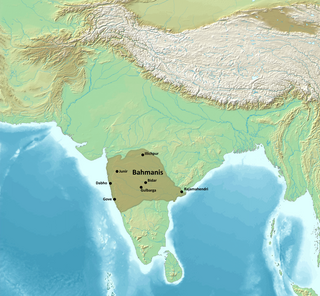A monarch is a head of state for life or until abdication, and therefore the head of state of a monarchy. A monarch may exercise the highest authority and power in the state, or others may wield that power on behalf of the monarch. Usually a monarch either personally inherits the lawful right to exercise the state's sovereign rights or is selected by an established process from a family or cohort eligible to provide the nation's monarch. Alternatively, an individual may proclaim oneself monarch, which may be backed and legitimated through acclamation, right of conquest or a combination of means.

Sultan is a position with several historical meanings. Originally, it was an Arabic abstract noun meaning "strength", "authority", "rulership", derived from the verbal noun سلطة sulṭah, meaning "authority" or "power". Later, it came to be used as the title of certain rulers who claimed almost full sovereignty without claiming the overall caliphate, or to refer to a powerful governor of a province within the caliphate. The adjectival form of the word is "sultanic", and the state and territories ruled by a sultan, as well as his office, are referred to as a sultanate.

Muslim period in the Indian subcontinent is conventionally said to have started in 712, after the conquest of Sindh and Multan by the Umayyad Caliphate under the military command of Muhammad ibn al-Qasim. It began in the Indian subcontinent in the course of a gradual conquest. The perfunctory rule by the Ghaznavids in Punjab was followed by Ghurids, and Sultan Muhammad of Ghor is generally credited with laying the foundation of Muslim rule in Northern India.

The Delhi Sultanate or the Sultanate of Delhi was a late medieval empire primarily based in Delhi that stretched over large parts of the Indian subcontinent, for 320 years (1206–1526). Following the invasion of South Asia by the Ghurid dynasty, five dynasties ruled over the Delhi Sultanate sequentially: the Mamluk dynasty (1206–1290), the Khalji dynasty (1290–1320), the Tughlaq dynasty (1320–1414), the Sayyid dynasty (1414–1451), and the Lodi dynasty (1451–1526). It covered large swaths of territory in modern-day India, Pakistan, and Bangladesh as well as some parts of southern Nepal.

The Bahmani Sultanate was a late medieval Muslim empire that ruled the Deccan Plateau in South India. The Bahmani Sultanate came to power in 1347 during the Rebellion of Ismail Mukh against the Tughlaq dynasty of Delhi after Ismail Mukh abdicated in favour of Zafar Khan, who would establish the Bahmani Sultanate. The Bahmani Sultanate was in perpetual war with its neighbors, including its rival to the south, the Vijayanagara Empire.

The Qutb Shahi dynasty was a Persianate Shia Islamic dynasty of Turkoman origin that ruled the Sultanate of Golkonda in southern India. After the collapse of the Bahmani Sultanate, the Qutb Shahi dynasty was established in 1512 AD by Sultan-Quli Qutb-ul-Mulk, better known though less correctly referred to in English as "Quli Qutb Shah".

The Malwa Sultanate was a late medieval kingdom in the Malwa region, covering the present day Indian states of Madhya Pradesh and south-eastern Rajasthan from 1401 to 1562. It was founded by Dilawar Khan, who following Timur's invasion and the disintegration of the Delhi Sultanate, in 1401, made Malwa an independent realm.

Malay Indonesians are ethnic Malays living throughout Indonesia. They are one of the indigenous peoples of the country. Indonesian, the national language of Indonesia, is a standardized form of Riau Malay. There were numerous kingdoms associated with the Indonesian Malays along with other ethnicities in what is now Indonesia, mainly on the islands of Borneo and Sumatra. These included Srivijaya, the Melayu Kingdom, Dharmasraya, the Sultanate of Deli, the Sultanate of Siak Sri Indrapura, the Riau-Lingga Sultanate, the Sultanate of Bulungan, Pontianak Sultanate, and the Sultanate of Sambas. The 2010 census states that there are 8 million Malays in Indonesia; this number comes from the classification of Malays in East Sumatra and the coast of Kalimantan which is recognized by the Indonesian government. This classification is different from the Malaysia and Singapore census which includes all ethnic Muslims from the Indonesian archipelago as Malays.

The Bengal Sultanate was a late medieval sultanate based in the Bengal region between the 14th and 16th century. It was the dominant power of the Ganges-Brahmaputra Delta, with a network of mint towns spread across the region. The Bengal Sultanate had a circle of vassal states in the Indian subcontinent, including parts of Odisha in the southwest, Arakan in the southeast, and Tripura in the east.

The Majeerteen Sultanate, or Majerteen Kingdom also known as Majeerteenia and Migiurtinia, was a Somali kingdom centered in the Horn of Africa. Ruled by Boqor Osman Mahamuud during its golden age, the sultanate controlled the areas which are now called Puntland. The earliest mention of the kingdom is the 16th century. The polity had all of the organs of an integrated modern state and maintained a robust trading network. It also entered into treaties with foreign powers and exerted strong centralized authority on the domestic front.
This page is based on this
Wikipedia article Text is available under the
CC BY-SA 4.0 license; additional terms may apply.
Images, videos and audio are available under their respective licenses.








